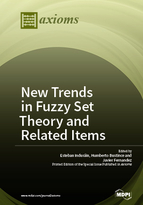New Trends in Fuzzy Set Theory and Related Items
A special issue of Axioms (ISSN 2075-1680). This special issue belongs to the section "Logic".
Deadline for manuscript submissions: closed (30 April 2018) | Viewed by 47241
Special Issue Editors
2. NavarraBiomed, Complejo Hospitalario de Navarra, 31006 Pamplona, Spain
3. Institute of Smart Cities, 31006 Pamplona, Spain
Interests: aggregation functions; theoretical aspects of fuzzy sets and their extensions; image processing; classification; decision making; bio-inspired algorithms; partial differential equations
Special Issues, Collections and Topics in MDPI journals
Interests: numerical representations of ordered structures; general topology; functional equations; real and functional analysis; fuzzy sets and systems; mathematical economics; social choice
Interests: aggregation functions; theoretical aspects of fuzzy sets and their extensions; image processing; classification; decision making; bio-inspired algorithms; partial differential equations
Special Issues, Collections and Topics in MDPI journals
Special Issue Information
Dear Colleagues,
We have the intention of launching a Special Issue of Axioms. The central topic in the Special Issue will be “fuzzy set theory”. We would provide an opportunity to showcase recent developments in the many branches of both theoretical and practical studies in Mathematics, which are related to fuzzy set theory and/or its extensions and generalizations. Among the topics that this Special Issue will address, we may consider the following non-exhaustive list:
Fuzzy sets and systems; Fuzzy Logic; Linguistic labels; Fuzzy numbers; Functional equations; Aggregation functions and operators; Extensions of fuzzy sets; Ordered structures; Fuzzy relations; Miscellaneous applications of fuzzy sets and their extensions, etc.
Needless to say, the Special Issue is open to receiving further ideas, apart from the aforementioned topics.
In the hopes that this initiative are of interest, we encourage you to submit your current research to be included in the Special Issue.
Best regards,
Dr. Javier Fernandez
Dr. Esteban Indurain
Prof. Dr. Humberto Bustince
Guest Editors
Manuscript Submission Information
Manuscripts should be submitted online at www.mdpi.com by registering and logging in to this website. Once you are registered, click here to go to the submission form. Manuscripts can be submitted until the deadline. All submissions that pass pre-check are peer-reviewed. Accepted papers will be published continuously in the journal (as soon as accepted) and will be listed together on the special issue website. Research articles, review articles as well as short communications are invited. For planned papers, a title and short abstract (about 100 words) can be sent to the Editorial Office for announcement on this website.
Submitted manuscripts should not have been published previously, nor be under consideration for publication elsewhere (except conference proceedings papers). All manuscripts are thoroughly refereed through a single-blind peer-review process. A guide for authors and other relevant information for submission of manuscripts is available on the Instructions for Authors page. Axioms is an international peer-reviewed open access monthly journal published by MDPI.
Please visit the Instructions for Authors page before submitting a manuscript. The Article Processing Charge (APC) for publication in this open access journal is 2400 CHF (Swiss Francs). Submitted papers should be well formatted and use good English. Authors may use MDPI's English editing service prior to publication or during author revisions.
Keywords
- Fuzzy sets
- Fuzzy logic
- Labels
- Aggregation operators
- Functional equations
- Ordered structures
- Numerical representability
- General topology
- Social choice
- Decision making;
- Image processing
- Type-2 fuzzy sets
- Extensions of fuzzy sets
- Fuzzy relations
- Copulas







